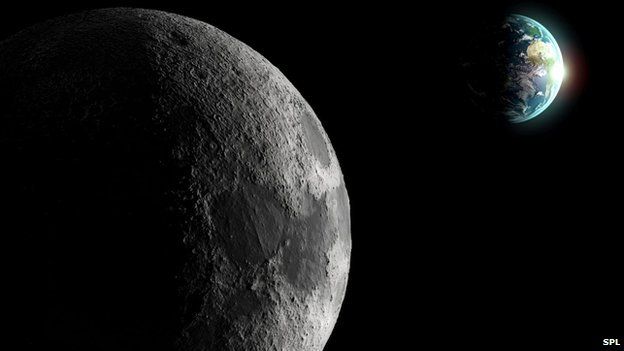Moon mystery: Why our Earth's satellite is lemon-shaped
- Published

Scientists have worked out the reasons for the distorted shape of our Moon.
A US team calculated the effect on the shape of the early Moon of tidal and rotational forces.
Writing in Nature, they say its own spin and the tidal tug of the Earth created a "lemon-shaped" satellite.
Lead researcher Ian Garrick-Bethell, from the University of California Santa Cruz, said this shape-shifting occurred when the Moon was mostly liquid beneath a thin outer crust of rock.
This interaction with the Earth also caused the Moon to shift slightly on its own axis.
"For the Earth and Mars and other bodies, we know that the dominant shape of the planet is due to its spin," he said.
"If you take a water balloon and start spinning it, it will bulge out at the equator, and on the Earth, we have something very similar to that."
Professor of planetary sciences Ian Garrick-Bethell explains what gave the Moon its lemon-like distorted shape
This effect, however, does not explain how "surprisingly distorted" our Moon is.
"It's spinning really slowly, and it's really far from the Earth, so it's not like tides today could be causing that."
Prof Garrick-Bethell's new explanation is that four billion years ago - when the Moon formed from the debris thrown out by a huge impact between early Earth and a so-called planetoid - was much closer to the Earth. This meant tides were stronger.
"The Moon was [also] spinning much faster," he told BBC News.
"So there's a variety of interesting things that could happen, at that time when the Moon was really hot, that could change its shape."
Heating and stretching
When the Moon first formed, it was liquid rock. As it cooled, the outer crust solidified and floated on this viscous ocean.
The gravitational tug of the Earth raised tides on the Moon that started to "flex and pull on that thin crust", said Prof Garrick-Bethell.
He and his colleagues were inspired in this idea by an earlier study of one of Jupiter's moon's Europa.
Europa has an ice crust floating on a liquid ocean of water.
Prof Garrick-Bethell's team realised that a similar effect could have occurred in the liquid rock ocean on the early Moon.
They also solved the mathematical problems caused by large craters and basins on the Moon's surface that formed after the crust solidified.
These have previously caused problems for past attempts to interpret its shape. They're essentially chunks of "missing Moon" that make it difficult to map its co-ordinates and work out how its original spherical shape would have been rearranged.
"We did a lot of work to estimate the uncertainties in the analysis that result from those gaps [in the data]," Prof Garrick-Bethell said.
The result, the researchers claim, is the best explanation yet of the Moon's odd shape.
- Published5 June 2014
- Published15 April 2014
- Published12 November 2010